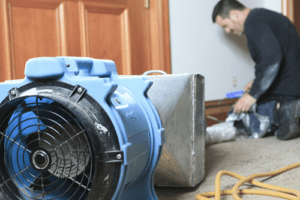When planning and budgeting for the maintenance needs of any commercial building, don’t overlook the areas that you can’t easily see, such as your ductwork. Periodic duct cleaning is something every building manager should think about to contribute to better indoor air quality and avoid the growth of mold. However, this isn’t the kind of task that you or a commercial cleaning crew could easily tackle on a “do it yourself” basis. Instead, this is one task best left to the HVAC professionals most familiar with the ducting systems in place throughout your building. Not only will they have the experience necessary, but they also have access to special air duct cleaning tools that make the job more straightforward and more thorough. What should you know about the cleaning process?
Most Cleanings Begin with a Visual Inspection
 You can’t clean what you can’t see — and to a certain extent, that’s true for professional duct cleaners, too. To know which tools to use and how long cleaning may take, it is important for the cleaners to gauge the level of accumulated dust and debris inside of the duct system. Therefore, the first tool you may see produced on the job site is a long, thin, and flexible camera. Contractors will often perform a visual inspection of the entire length of the ducting system to both understand its layout and assess its condition. Most often, these cameras enter through vents or other access points; sometimes, contractors may need to create an entrance in a duct to get a better look. Don’t worry: any changes they make will receive a permanent fix by the end of the job.
You can’t clean what you can’t see — and to a certain extent, that’s true for professional duct cleaners, too. To know which tools to use and how long cleaning may take, it is important for the cleaners to gauge the level of accumulated dust and debris inside of the duct system. Therefore, the first tool you may see produced on the job site is a long, thin, and flexible camera. Contractors will often perform a visual inspection of the entire length of the ducting system to both understand its layout and assess its condition. Most often, these cameras enter through vents or other access points; sometimes, contractors may need to create an entrance in a duct to get a better look. Don’t worry: any changes they make will receive a permanent fix by the end of the job.
How Professionals Use Air Duct Cleaning Tools
With the system analyzed, it’s time to begin cleaning. Your chosen crew will initially seal off most of the air vents in the area to be cleaned to avoid blowing any dust out into working areas of the building. With most of the spaces sealed off, the next step is the connection of a high-powered vacuum to the ductwork. Sometimes portable but often attached to a vehicle outside, this souped-up vacuum helps to create negative air pressure inside of the duct. In other words, anything the cleaning kicks up into the air will stay in the ductwork but immediately begin to flow towards the vacuum.
Setup at this stage may take some time, as adjustments to the air duct cleaning tools may be necessary based on the ductwork design. For example, large buildings often have reducing plenum systems, in which ductwork narrows progressively to maintain air volume and pressure. Achieving the right pressure gradient through these spaces is critical for thorough cleaning.
With the proper air pressure achieved, the cleaning begins. The most popular tool in use today is the air whip. Another long, flexible tube, the air whip has a flexible piece of plastic on the end. When powered with pressurized air, the plastic whips around wildly in all directions — knocking loose thick layers of dust inside the ducts. Rotary brushes of varying stiffness follow the air whip to directly clean the surface of the ductwork after the vacuum pulls out all the dust. For larger and more complex systems, such as when a reducing trunk is in use, cleaning may again take longer. In a reducing trunk setup, there are many more branches to clean, which may necessitate multiple entry points.
Other Important Things to Know About Duct Cleaning
The cleaning method itself is straightforward, and so too are the reasons why you should invest in this service every so often. Periodic cleaning allows you to remove mold and mildew that may accumulate and grow in your ducts, especially during the humid summer months, before it impacts employee health. Removing rodent droppings, dander, and other duct contaminants can also reduce the occurrence of allergies, which in turn keeps productivity at higher levels. As for how frequently should you have your ducts cleaned? That’s a great question — the typical recommendation is once at least every five years, though your building may require more cleaning frequently depending on the type of work performed there, whether it uses carpet, and other factors.
Choose a Qualified Contractor with the Right Tools
If you’ve spotted the signs that indicate you’re overdue for a duct cleaning, or if staff are complaining about the quality of the air, what next? Connect with qualified commercial HVAC contractors and know what kinds of questions to ask so you can make an informed decision about the services you need. With the right service provider on your side, you can trust that your ducts will receive a prompt and thorough cleaning with the latest in advanced air duct cleaning tools. Are you unsure if your ducts need cleaning? Consider scheduling an inspection for a definitive answer. Better air is just a quick service visit away.

